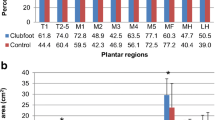Abstract
Current methods of treating congenital clubfeet provide high rates of functional outcomes. Despite the clinical outcomes, radiographic assessment suggests residual equinus deformity of the hindfoot. It is unclear whether these deformities result in abnormal foot-floor pressures and whether they correlate with clinical outcome. We evaluated 28 feet in 20 patients following Ponseti treatment for clubfoot by clinical and pedobarographic examination a mean of 33 months after removal of the last cast. The data were compared to age- and weight-matched normal subjects and to the unaffected foot in the unilaterally affected patients. Despite ankle range of motion of 30° and a physiologic hindfoot valgus alignment in 19 cases, pedobarography suggested differences in maximum force, impulse, contact area, and peak pressure compared to normal subjects. Compared to the unaffected foot the only difference was reduced peak pressure over the medial hindfoot and forefoot with increased pressure over the lateral midfoot. Similar to radiographic abnormalities in studies on treated clubfeet with good functional outcome, pedobarographic analyses show differences compared to a control group. The value of pedobarographic analysis for predicting successful treatment of congenital clubfoot is questionable since it does not correlate with the clinical outcome in patients treated with the Ponseti method.
Level of Evidence: Level IV, diagnostic study. See the Guidelines for Authors for a complete description of levels of evidence.






Similar content being viewed by others
References
Abdelgawad AA, Lehman WB, van Bosse HJ, Scher DM, Sala DA. Treatment of idiopathic clubfoot using the Ponseti method: minimum 2-year follow-up. J Pediatr Orthop B. 2007;16:98–105.
Aronson J, Puskarich CL. Deformity and disability from treated clubfoot. J Pediatr Orthop. 1990;10:109–119.
Bosch K, Gerss J, Rosenbaum D. Preliminary normative values for foot loading parameters of the developing child. Gait Posture. 2007;26:238–247.
Cavanagh PR, Rodgers MM, Iiboshi A. Pressure distribution under symptom-free feet during barefoot standing. Foot Ankle. 1987;7:262–276.
Cooper DM, Dietz FR. Treatment of idiopathic clubfoot. A thirty-year follow-up note. J Bone Joint Surg Am. 1995;77:1477–1489.
Dixon SJ. Use of pressure insoles to compare in-shoe loading for modern running shoes. Ergonomics. 2008;51:1503–1514.
El-Hawary R, Karol LA, Jeans KA, Richards BS. Gait analysis of children treated for clubfoot with physical therapy or the Ponseti cast technique. J Bone Joint Surg Am. 2008;90:1508–1516.
Favre P, Exner GU, Drerup B, Schmid D, Wetz HH, Jacob HA. The contralateral foot in children with unilateral clubfoot: a study of pressures and forces involved in gait. J Pediatr Orthop. 2007;27:54–59.
Flynn JM, Donohoe M, Mackenzie WG. An independent assessment of two clubfoot-classification systems. J Pediatr Orthop. 1998;18:323–327.
Haft GF, Walker CG, Crawford HA. Early clubfoot recurrence after use of the Ponseti method in a New Zealand population. J Bone Joint Surg Am. 2007;89:487–493.
Hee HT, Lee EH, Lee GS. Gait and pedobarographic patterns of surgically treated clubfeet. J Foot Ankle Surg. 2001;40:287–294.
Hennig EM, Staats A, Rosenbaum D. Plantar pressure distribution patterns of young school children in comparison to adults. Foot Ankle Int. 1994;15:35–40.
Herzenberg JE, Radler C, Bor N. Ponseti versus traditional methods of casting for idiopathic clubfoot. J Pediatr Orthop. 2002;22:517–521.
Hughes J, Pratt L, Linge K, Clark P, Klenerman L. Reliability of pressure measurements: the EMED F system. Clin Biomech. 1991;6:14–18.
Ippolito E, Farsetti P, Caterini R, Tudisco C. Long-term comparative results in patients with congenital clubfoot treated with two different protocols. J Bone Joint Surg Am. 2003;85:1286–1294.
Laaveg SJ, Ponseti IV. Long-term results of treatment of congenital club foot. J Bone Joint Surg Am. 1980;62:23–31.
Maton B, Wicart P. Centrally adaptations in unilateral idiopathic clubfoot children following conservative treatment. J Electromyogr Kinesiol. 2005;15:72–82.
Morag E, Cavanagh PR. Structural and functional predictors of regional peak pressures under the foot during walking. J Biomech. 1999;32:359–370.
Morcuende JA. Congenital idiopathic clubfoot: prevention of late deformity and disability by conservative treatment with the Ponseti technique. Pediatr Ann. 2006;35:128–30, 132–136.
Morcuende JA, Abbasi D, Dolan LA, Ponseti IV. Results of an accelerated Ponseti protocol for clubfoot. J Pediatr Orthop. 2005;25:623–626.
Morcuende JA, Dolan LA, Dietz FR, Ponseti IV. Radical reduction in the rate of extensive corrective surgery for clubfoot using the Ponseti method. Pediatrics. 2004;113:376–380.
Ponseti IV, El-Khoury GY, Ippolito E, Weinstein SL. A radiographic study of skeletal deformities in treated clubfeet. Clin Orthop Relat Res. 1981;30–42.
Radler C, Manner HM, Suda R, Burghardt R, Herzenberg JE, Ganger R, Grill F. Radiographic evaluation of idiopathic clubfeet undergoing Ponseti treatment. J Bone Joint Surg Am. 2007;89:1177–1183.
Thacker MM, Scher DM, Sala DA, van Bosse HJ, Feldman DS, Lehman WB. Use of the foot abduction orthosis following Ponseti casts: is it essential? J Pediatr Orthop. 2005;25:225–228.
Wearing S, Urry S, Smeathers J. The effect of visual targeting on ground reaction force and temporospatial parameters of gait. Clin Biomech. 2000;15:583–591.
Widhe T, Berggren L. Gait analysis and dynamic foot pressure in the assessment of treated clubfoot. Foot Ankle Int. 1994;15:186–190.
Author information
Authors and Affiliations
Corresponding author
Additional information
Each author certifies that he or she has no commercial associations (eg, consultancies, stock ownership, equity interest, patent/licensing arrangements, etc) that might pose a conflict of interest in connection with the submitted article.
Each author certifies that his or her institution has waived or does not require approval for the human protocol for this investigation and that all investigations were conducted in conformity with ethical principles of research.
About this article
Cite this article
Sinclair, M.F., Bosch, K., Rosenbaum, D. et al. Pedobarographic Analysis Following Ponseti Treatment for Congenital Clubfoot. Clin Orthop Relat Res 467, 1223–1230 (2009). https://doi.org/10.1007/s11999-009-0746-5
Received:
Accepted:
Published:
Issue Date:
DOI: https://doi.org/10.1007/s11999-009-0746-5




